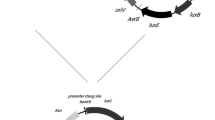Abstract
An Escherichia coli bioreporter harboring the phenol-inducible mphK promoter (P mphK ) from Acinetobacter calcoaceticus PHEA-2 fused to a β-galactosidase gene (lacZ) and the regulator gene (mopR) of A. calcoaceticus NCIB8250 was constructed to detect phenol. P mphK containing three inverted repeats (IR1, IR2 and IR3) upstream of mphK was activated by the regulator MopR in the presence of phenol. Deletion analysis of P mphK revealed that IR2 and IR3 were essential for promoter activity, while IR1 was involved in transcriptional repression. The sensitivity of the bioreporter for the detection of phenol (0.1–5 μM) was improved by about 100% through deletion of IR1 in P mphK .

Similar content being viewed by others
References
Abd-El-Haleem D, Ripp S, Scott C, Sayler GS (2002) A luxCDABE-based bioluminescent bioreporter for the detection of phenol. J Ind Microbiol Biotechnol 29:233–237
Abd-El-Haleem D, Ripp S, Zaki S, Sayler GS (2007) Detection of nitrate/nitrite bioavailability in wastewater using a luxCDABE-based Klebsiella oxytoca bioluminescent bioreporter. J Microbiol Biotechnol 17:1254–1261
Daubaras D, Chakrabarty AM (1992) The environment, microbes and bioremediation: microbial activities modulated by the environment. Biodegradation 3:125–135
Ehrt S, Schirmer F, Hillen W (1995) Genetic organization, nucleotide sequence and regulation of expression of genes encoding phenol hydroxylase and catechol 1,2-dioxygenase in Acinetobacter calcoaceticus NCIB8250. Mol Microbiol 18:13–20
Garmendia J, Devos D, Valencia A, de Lorenzo V (2001) À la carte transcriptional regulators: unlocking responses of the prokaryotic enhancer-binding protein XylR to non-natural effectors. Mol Microbiol 42:47–59
Hay AG, Rice JF, Applegate BM, Bright NG, Sayler GS (2000) A bioluminescent whole-cell reporter for detection of 2,4-dichlorophenoxyacetic acid and 2,4-dichlorophenol in soil. Appl Environ Microbiol 66:4589–4594
Keane A, Phoenix P, Ghoshal S, Lau PC (2002) Exposing culprit organic pollutants: a review. J Microbiol Methods 49:103–119
King JM, Digrazia PM, Applegate B, Burlage R, Sanseverino J, Dunbar P, Larimer F, Sayler GS (1990) Rapid, sensitive bioluminescent reporter technology for naphthalene exposure and biodegradation. Science 249:778–781
Santos PM, Blatny JM, Di Bartolo I, Valla S, Zennaro E (2000) Physiological analysis of the expression of the styrene degradation gene cluster in Pseudomonas fluorescens ST. Appl Environ Microbiol 66:1305–1310
Schirmer F, Ehrt S, Hillen W (1997) Expression, inducer spectrum, domain structure, and function of MopR, the regulator of phenol degradation in Acinetobacter calcoaceticus NCIB8250. J Bacteriol 179:1329–1336
Tropel D, van der Meer JR (2004) Bacterial transcriptional regulators for degradation pathways of aromatic compounds. Microbiol Mol Biol Rev 68:474–500
Tropel D, Bähler A, Globig K, van der Meer JR (2004) Design of new promoters and of a dual-bioreporter based on cross-activation by the two regulatory proteins XylR and HbpR. Environ Microbiol 6:1186–1196
Watanabe K, Teramoto M, Futamata H, Harayama S (1998) Molecular detection, isolation, and physiological characterization of functionally dominant phenol-degrading bacteria in activated sludge. Appl Environ Microbiol 64:4396–4402
Wise AA, Kuske CR (2000) Generation of novel bacterial regulatory proteins that detect priority pollutant phenols. Appl Environ Microbiol 66:163–169
Xu Y, Chen M, Zhang W, Lin M (2003) Genetic organization of genes encoding phenol hydroxylase, benzoate 1,2-dioxygenase alpha subunit and its regulatory proteins in Acinetobacter calcoaceticus PHEA-2. Curr Microbiol 46:235–240
Yagur-Kroll S, Bilic B, Belkin S (2009) Strategies for enhancing bioluminescent bacterial sensor performance by promoter region manipulation. Microb Biotechnol. doi:10.1111/j.1751-7915.2009.00149.x
Acknowledgments
We thank Dr. Russell A. Nicholson for critical reading of the manuscript, and thank Professor Hillen for pWH841. This work was supported by grants from the National Basic Research (973) Program of China (No. 2007CB707805) and the National High-Tech (863) Program of China (No. 2007AA021304).
Author information
Authors and Affiliations
Corresponding author
Electronic supplementary material
Below is the link to the electronic supplementary material.
Rights and permissions
About this article
Cite this article
Peng, Z., Yan, Y., Xu, Y. et al. Improvement of an E. coli bioreporter for monitoring trace amounts of phenol by deletion of the inducible σ54-dependent promoter. Biotechnol Lett 32, 1265–1270 (2010). https://doi.org/10.1007/s10529-010-0317-6
Received:
Revised:
Accepted:
Published:
Issue Date:
DOI: https://doi.org/10.1007/s10529-010-0317-6




